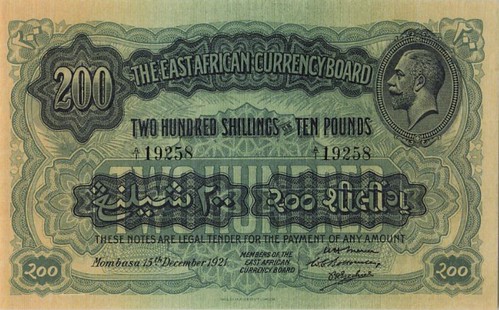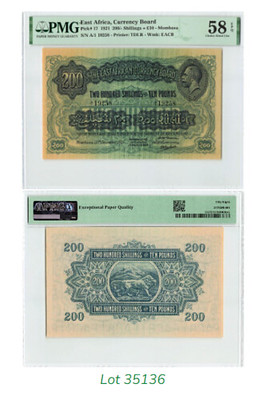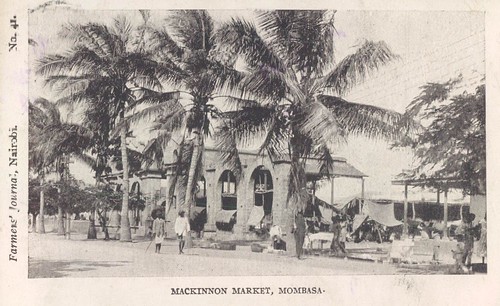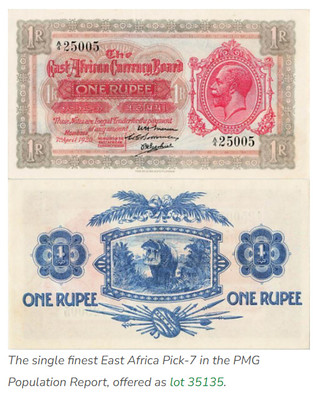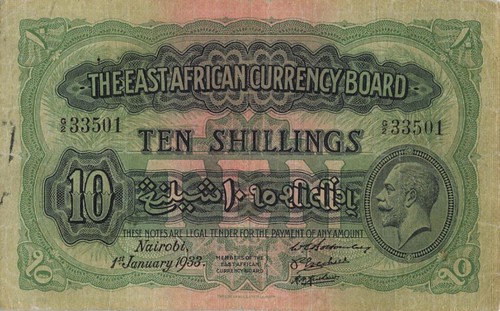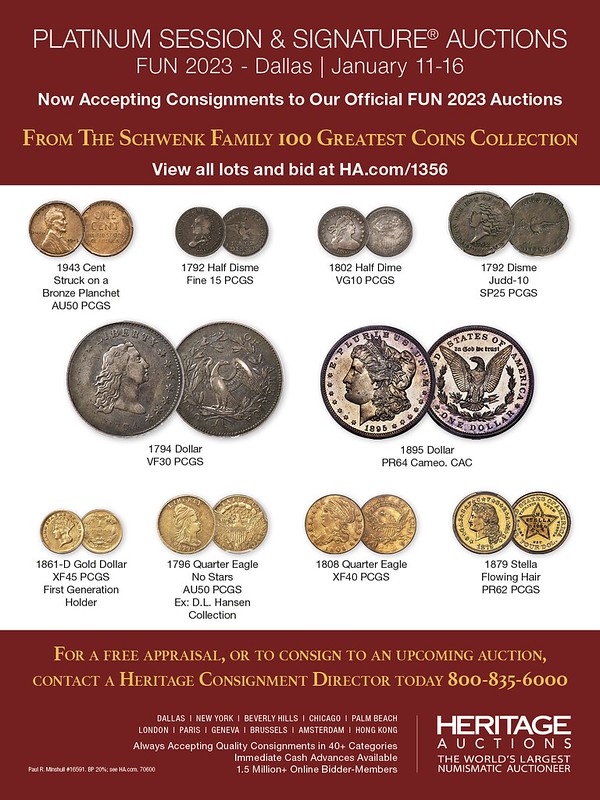
PREV ARTICLE
NEXT ARTICLE
FULL ISSUE
PREV FULL ISSUE
V25 2022 INDEX E-SYLUM ARCHIVE WBNA OFFERS EAST AFRICAN RARITIESWorld Banknote Auctions offers several East African Rarities in their upcoming Auction 35. Here's a blog post by owner Dennis Hengeveld with more details. -Editor
Offered in World Banknote Auctions sale 35 as lot number 35136 is a major African rarity from the British colony of East Africa. Dated 15th December 1921 and issued at Mombasa (in present-day Kenya) this 200 Shillings or 10 Pounds is listed in the Pick catalog of World paper Money as Pick-17. It is the third highest denomination of the 1921 series issued for East Africa. It is preceded by a series issued under the East Africa protectorate and a rare series issued in 1920 which was quickly replaced by this series denominated in Shillings in 1921. A classic African colonial banknote, this example is one of just three in the PMG population report and the only example certified by PMG as having
British East Africa was officially known as the Colony and Protectorate of Kenya. Nairobi was its capital, but the largest city was Mombasa, which around 1921 had a population of 32,000. Mombasa was located on the coast and was first settled as a trading town on an island as early as 900 A.D., with the first mention of the city coming from a Moroccan traveler in the 14th century. Mombasa was an important port city for trade with the Indian subcontinent, and by 1920 the city and colony had a large number of Indians, who outnumbered Europeans about 2.5:1. The Arab population was similar to the Europeans. Native Africans formed by far the largest group, with over 2,000,000 estimated to live in the colony under British rule at the time the note offered in this sale was issued. Before the region issued its own coins and currency the Indian Rupee circulated in the region, the direct result of the trade with India and stressing its importance. The East African Rupee was introduced in 1906, then replaced in 1920 by the East African Florin, and finally in 1921 by the East African Shilling. First banknotes were introduced in 1906 (but dated 1905) and consisted of an entire series of uniface notes from 5 Rupees to 1000 Rupees. The second series was introduced in 1912 and were similar in design to the first series, although it is believed this series (which was issued with several dates) only went up to the 500 Rupees. These notes were not demonetized until 1930 allowing ample time for holders of these notes to exchange them for updated notes.
While not of the same rarity as the 200 Shillings, the condition of this piece is phenomenal, and it is certainly the nicest of this type we have handled. As mentioned previously the East African Rupee was briefly replaced by the East African Florin (which included a 1 Rupee of the same design, up to a 500 Rupees). This series was then replaced, on par, by the 1921 issue denominated in Shillings and Pounds. While not known at the time, this would be the final series issued at Mombasa, as all later issues were issued at Nairobi. The 1921 series also includes a 1 Rupee (of the same design as the 1920 issue but now as 1 Shilling), a 5 Shillings, 10 Shillings, 20 Shillings, 100 Shillings, 200 Shillings (offered by World Banknote Auctions), 1000 Shillings and 10,000 Shillings. While the lower denominations no doubt circulated in general commerce, it is believed that the higher denominations were reserved for larger transactions and interbank transfers, as they represented large sums of money that would have little use in day-to-day transactions. Later issues under King George VI would include a 1000 Shillings and 10,000 Shillings (both extremely rare) but the 200 Shillings offered in this sale would be the last of that denomination issued in British East Africa. To further illustrate the lack of demand for high denominations, the last two series issued under Queen Elizabeth II would no longer include denominations above 100 Shillings (or 5 Pounds). The 1933 issue for East Africa uses the same basic design as the 1921 series, but was issued at Nairobi. This series did not include values above the 100 Shillings, as the supply of higher denominations provided by the 1921 series was deemed sufficient for the demand at the time. In fact, demand for a 200 Shillings (or 10 Pounds) note was so low that this denomination would never be printed again after the 1921 issue. For the advanced collector of British East Africa this offers an extremely infrequent opportunity to acquire a high grade example of this rarity. In the philatelic world stamps of this region have been avidly collected since they were first issued, and in today's numismatic world the banknotes of the region have caught on. They are some of the most popular and iconic series of banknotes an advanced collector can acquire. Over the past century the region has seen rapid development, and trade and tourism now play an important role to its economy, with Kenya visited by millions of tourists each year to enjoy the spectacular scenery and wildlife. World Banknote Auctions is honored to offer this rarity in fantastic grade, which is offered in session 1 of sale 35, with live bidding on December 1st at 1 PM EST / 10 AM PST. Besides the East African rarities discussed above the two sessions of sale 35 offer almost 1000 lots from around the world, ranging from modern notes in high grade to rarities seldom seen at public auction.
To read the complete article, see:
Wayne Homren, Editor The Numismatic Bibliomania Society is a non-profit organization promoting numismatic literature. See our web site at coinbooks.org. To submit items for publication in The E-Sylum, write to the Editor at this address: whomren@gmail.com To subscribe go to: https://my.binhost.com/lists/listinfo/esylum All Rights Reserved. NBS Home Page Contact the NBS webmaster 
|
